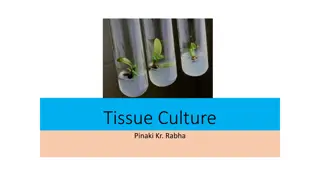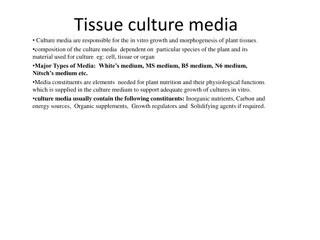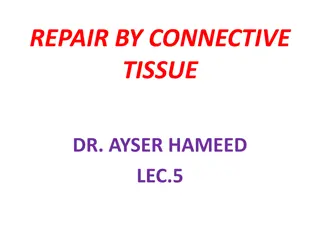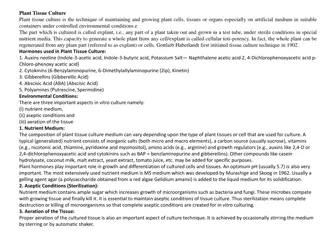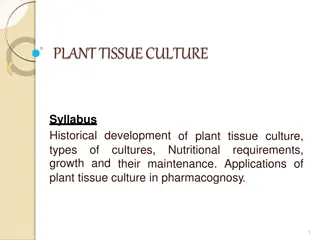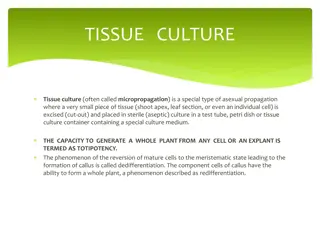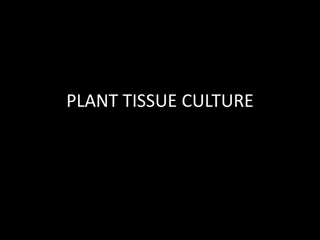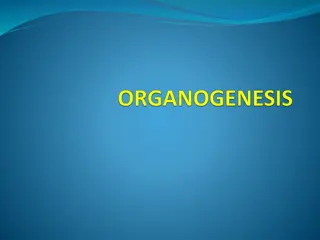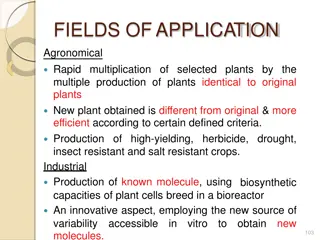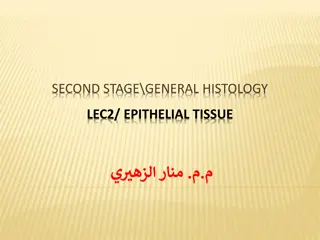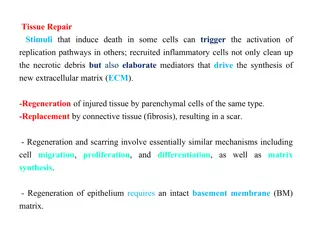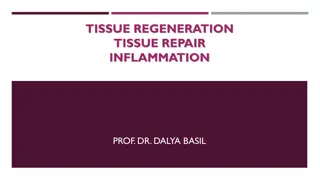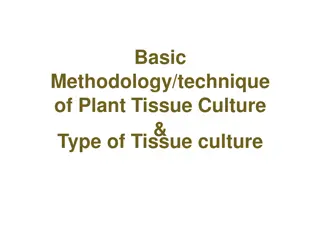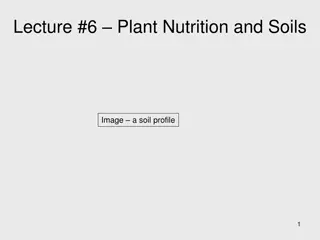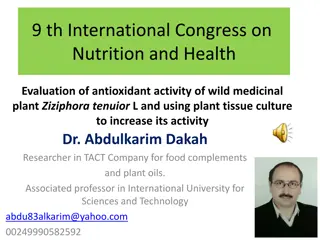Plant Tissue Culture and Regeneration Pathways
Plant tissue culture techniques such as Organogenesis and Somatic Embryogenesis play a crucial role in regenerating whole plants from meristem cells. The process involves the formation of organs directly from explants or callus structures and the production of adventitious organs like roots, shoots, and leaves. Different pathways like Direct Organogenesis and Indirect Organogenesis showcase the ability of non-meristematic plant tissues to develop various organs. Somatic Embryogenesis leads to the formation of adventitious embryos from somatic cells, involving different types of embryogenic cells like PEDCs and IEDCs. These methods are essential for propagating plants and studying developmental processes.
Download Presentation

Please find below an Image/Link to download the presentation.
The content on the website is provided AS IS for your information and personal use only. It may not be sold, licensed, or shared on other websites without obtaining consent from the author.If you encounter any issues during the download, it is possible that the publisher has removed the file from their server.
You are allowed to download the files provided on this website for personal or commercial use, subject to the condition that they are used lawfully. All files are the property of their respective owners.
The content on the website is provided AS IS for your information and personal use only. It may not be sold, licensed, or shared on other websites without obtaining consent from the author.
E N D
Presentation Transcript
Plant Regeneration Pathways Existing Meristems (Microcutting) Uses meristematic cells to regenerate whole plant. Organogenesis Relies on the production of organs either directly from an explant or callus structure Somatic Embryogenesis Embryo-like structures which can develop into whole plants in a way that is similar to zygotic embryos are formed from somatic cells (Source:Victor. et al., 2004)
The ability of non-meristematic plant tissues to form various organs de novo. The formation of adventitious organs The production of roots, shoots or leaves These organs may arise out of pre-existing meristems or out of differentiated cells This may involve a callus intermediate but often occurs without callus.
Indirect organogenesis Explant Callus Meristemoid Primordium
Direct Organogenesis Direct shoot/root formation from the explant
The formation of adventitious embryos The production of embryos from somatic or non- germ cells. It usually involves a callus intermediate stage which can result in variation among seedlings
Types of embryogenic cells Pre-embryogenic determined cells, PEDCs The cells are committed to embryonic development and need only to be released. Such cells are found in embryonic tissue. Induced embryogenic determined cells, IEDCs In majority of cases embryogenesis is through indirect method. Specific growth regulator concentrations and/or cultural conditions are required for initiation of callus and then redetermination of these cells into the embryogenic pattern of development.
Various terms for non- zygotic embryos Adventious embryos Somatic embryos arising directly from other organs or embryos. Parthenogenetic embryos (apomixis) Somatic embryos are formed by the unfertilized egg. Androgenetic embryos Somatic embryos are formed by the male gametophyte.
Somatic Embryogenesis and Organogenesis Both of these technologies can be used as methods of micropropagation. It is not always desirable because they may not always result in populations of identical plants. The most beneficial use of somatic embryogenesis and organogenesis is in the production of whole plants from a single cell (or a few cells).
Somatic embryogenesis differs from organogenesis
Bipolar structure with a closed radicular end rather than a monopolar structure. The embryo arises from a single cell and has no vascular connection with the mother tissue.
Two routes to somatic embryogenesis (Sharp et al., 1980) Direct embryogenesis Embryos initiate directly from explant in the absence of callus formation. Indirect embryogenesis Callus from explant takes place from which embryos are developed.
Direct somatic embryogenesis Direct embryo formation from an explant
Indirect Somatic Embryogenesis Explant Callus Embryogenic Maturation Germination 1. Calus induction 2. Callus embryogenic development 3. Multiplication 4. Maturation 5. Germination
Induction Auxins required for induction Proembryogenic masses form 2,4-D most used NAA, dicamba also used
Development Auxin must be removed for embryo development Continued use of auxin inhibits embryogenesis Stages are similar to those of zygotic embryogenesis Globular Heart Torpedo Cotyledonary Germination (conversion)
Maturation Require complete maturation with apical meristem, radicle, and cotyledons Often obtain repetitive embryony Storage protein production necessary Often require ABA for complete maturation ABA often required for normal embryo morphology Fasciation Precocious germination
Germination May only obtain 3-5% germination Sucrose (10%), mannitol (4%) may be required Drying (desiccation) ABA levels decrease Woody plants Final moisture content 10-40% Chilling Decreases ABA levels Woody plants
Somatic embryogenesis as a means of propagation is seldom used High probability of mutations The method is usually rather difficult. Losing regenerative capacity become greater with repeated subculture Induction of embryogenesis is very difficult with many plant species. A deep dormancy often occurs with somatic embryogenesis
Peanut somatic embryogenesis Peanut somatic embryogenesis
Callus During callus formation there is some degree of dedifferentiation both in morphology and metabolism, resulting in the lose the ability to photosynthesis. Callus cultures may be compact or friable. Compact callus shows densely aggregated cells Friable callus shows loosely associated cells and the callus becomes soft and breaks apart easily. Habituation: The lose of the requirement for auxin and/or cytokinin by the culture during long-term culture.
Cell-suspension cultures When friable callus is placed into the appropriate liquid medium and agitated, single cells and/or small clumps of cells are released into the medium and continue to grow and divide, producing a cell-suspension culture. The inoculum used to initiate cell suspension culture should neither be too small to affect cells numbers nor too large too allow the build up of toxic products or stressed cells to lethal levels. When callus pieces are agitated in a liquid medium, they tend to break up.
Suspensions are much easier to bulk up than callus since there is no manual transfer or solid support Cell suspension culture techniques are very important for plant biotransformation and plant genetic engineering.
Protoplast culture The isolation and culture of plant protoplasts in vitro
Protoplast The living material of a plant or bacterial cell, including the protoplasm and plasma membrane after the cell wall has been removed.
Callus Culture Callus: An un-organised mass of cells, produced when explants are cultured on the appropriate solid medium, with both an auxin and a cytokinin and correct conditions. A tissue that develops in response to injury caused by physical or chemical means Most cells of which are differentiated although may be and are often highly unorganized within the tissue
Callus formation 1. Meristems 2. Leaf sections Re-differentiation? De-differentiation 3. Bulb sections Explants Callus 4. Embryos 5. Anthers Protoplasts 6. Nucellus Development Suspension cells Organs (leaves, roots, shoots, flowers,...)
Cloning Using the somatic cells of a multicellular organism to generate a new organism Each clone is genetically identical to the parent plant.
THANK YOU THANK YOU


